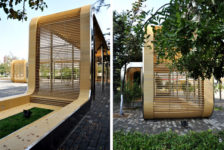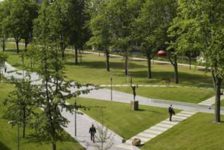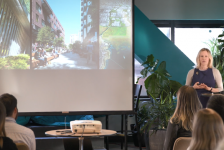Does landscape architecture need to die so that we can see the birth of a complete profession? Now more than ever, landscape architecture is both highly visible and influential. Many circles now see the discipline as usurping architecture in terms of its ability to catalyze urban form. This cultural shift — fostered largely by a growing public awareness of the benefits of a quality urban realm, a reading of the city as landscape, and an admittance among design professions that landscape architects are today most appropriate to respond to this condition — brings forth questions about the future of the profession. But what if landscape architecture was to be no more? I speculate a different future — one that witnesses the marriage of landscape architect and architect into a singular, all-inclusive design discipline. Visions for the future of the Anthropocene and the contemporary city writ large need to meet the demands of population increase, coupled with a decrease in habitable and arable land, and critical resources of air, water, food, and raw materials. By necessity, we must learn to better imbricate edifice and environment. The result would be genuine sustainability — a word that today has lost much of its meaning, but whose tenet is forcing architecture and landscape architecture to coalesce.
More Top Articles on LAN
- 10 of the Most Common Mistakes People Make in Planting Design and How to Avoid Them
- Interested But Not Confident? – Know How to be Good at Hand Drawings
- Top 10 YouTube Tutorials for Technical Drawing
A Melting Pot of Design Professions Under One Roof
Rather than the dichotomizing of building/landscape that often leads to hermetically sealed practices (not to mention gaudy buildings sited in terrain like foreign objects and lacking any meaningful dialogue with existing locales), myriad practices today now possess a melangé of design professions under one roof. This amalgam of architecture, interior architecture, and landscape architecture can lead to hybridization, innovation, and fertile approaches to constructing the world we inhabit. What would this amalgamation of professions look like? Kim Wilkie, a British landscape architect and Honorary Fellow of the Royal Institute of British Architects, cogitates a “return to the 18th century concept of architect in a complete role”[1], wherein the conventionally accepted confines of 20th century professional design roles are rearranged or, in the case of some recent built work around the world, almost reversed.
Remembering The Experts
Eighteenth-century designers such as Sir John Vanbrugh (1664–1726) and William Kent (1685–1748), for example, worked as both architects and landscape designers. Kent is considered a father figure of modern landscape gardening who “leaped the fence and saw that all nature was a garden”[2]. He lacked a classical education but nonetheless possessed deft craftsmanship in not only architecture and landscape design, but also in painting and theater set design.[3] The famed Rousham Gardens, in Oxfordshire, attest to this and are some of Kent’s superlative landscape design work. Many of his other landscapes were designed to complement his own architectural work.[4]

Bluff Creek and the new Playa Vista residential development on the Ballona wetlands, in Los Angeles, California. The Hollywood Hills, and behind them, the Verdugo Mountains, are seen in the distance. Photo credit: Downtowngal. Licensed under CC-SA 4.0, 3.0, 2.5, 2.0 and 1.0. Image source.
Playa Vista Central Park on Los Angeles
If we fast-forward to the present day, we again see this admixture. Sometimes referred to as “earthi-tecture”, this is no anomalous act. Completed in 2010, Playa Vista Central Park on Los Angeles’ West Side is an eight-acre slice of urban infrastructure designed by architect Michael Maltzan in collaboration with landscape architect James Burnett from Houston and Boston-based firm The Office of James Burnett. The design emphasizes architectural forms and textures through selective plant matter and materials, reinforcing the spatial experiences within the park and blurring the lines between the two disciplines. Another of noteworthy precedence is the Los Angeles Museum of the Holocaust by Belzberg Architects. Submerged into the terrain of Pan Pacific Park, the museum is understood as a continuous, topologically formed structure through the blending of concrete and vegetal hues and textures with those already in existence in the park, extending them onto the building and thus muddling the line between environment and edifice. This overlap is, however, not a new phenomenon. Rem Koolhaas, the esteemed Dutch urbanist and architect, has long prompted dissolution of traditionally established terminologies in favor of reading the urban territory as interconnected landscape tissue.[5] Along with Koolhaas, stalwart urban designers such as Adriaan Geuze of West 8 and Zaha Hadid of Zaha Hadid Architects, for example, have for years repudiated any inelastic hierarchies around architecture, landscape, and infrastructure.[6] In their work, they explore both the architecturalization of landscape and the landscapification of architecture.

Los Angeles Museum of the Holocaust Designed by Belzberg Architects. Photo credit: Belzarch. Licensed under CC-SA 3.0. Image source.
References
1. Wilkie, K. The Future of Landscape Architecture. 2000; Available from: https://www.kimwilkie.com/talks/the-future-of-landscape-architecture/. 2. Walpole, H., The History of the Modern Taste in Gardening, ed. John D. Hunt (New York: Ursus, 1995). 22: p. 313. 3. Rogers, E.B., Landscape Design: A Cultural and Architectural History. Vol. 486. 2001: Harry N. Abrams New York. 4. Allain, Y.-M. and J. Christiany, L’art des jardins en Europe. 2006, Citadelle at Mazenot, Paris. p. 280. 5. Koolhaas, R., et al., Politics-Poetics Documenta X, The Book. 1997: Germany: Cantz Verlag. 6. Angélil, M. and A. Klingmann, Hybride Morphologien: Infrastruktur, Architektur, Landschaft. Daidalos, 1999. 73(10): p. 16-24.
Recommended Reading
- Landscape Architecture: An Introduction by Robert Holden
- Landscape Architecture, Fifth Edition: A Manual of Environmental Planning and Design by Barry Starke
Article by Paul McAtomney
Published in Blog








